|
 |
 |
| Adult, Los Angeles County |
Adult, San Diego County |
 |
 |
 |
 |
| Adult, Los Angeles County |
Underside of Adult,
Los Angeles County |
 |
 |
 |
 |
| Adult, Los Angeles County |
Adult, Los Angeles County,
coiled in a defensive position. |
Underside of Adult,
Los Angeles County |
 |
 |
 |
 |
| Adult, Los Angeles County |
Adult, San Diego County
|
Adult and juvenile, San Diego County |
Underside of adult,
Los Angeles County |
 |
 |
 |
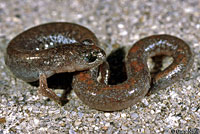 |
| Adult, Los Angeles County |
Adult, Los Angeles County |
Adult, Riverside County |
Adult, Los Angeles County |
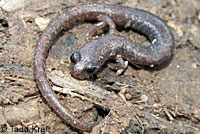 |
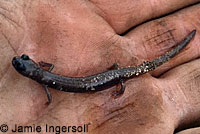 |
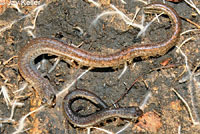 |
 |
| Adult, Orange County © Tadd Kraft |
Sub-adult, dug up next to an underground water pipe in Palm Springs, Riverside County © Jamie Ingersoll
The Garden Slender Salamander has extended its range east into some irrigated and landscaped desert areas such as Palm Springs. |
Adult and juvenile, San Diego County
© Jay Keller
|
Adult from the introduced population in Bakersfield, Kern County © Ryan Sikola |
 |
 |
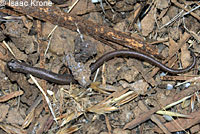 |
| Three adults, Santa Catalina Island © Isaac Krone |
| |
|
|
|
Comparisons With Sympatric Slender Salamanders |
| |
B. m. major
B. nigriventris |
Coexists with B. nigriventris - Black-bellied Slender Salamander, in some mountains in Los Angeles and Orange counties.
Ongoing surveys have found that both species occur throughout most of the L.A. Basin, as well as in the mountains and foothills.
B. m. major is the larger, more robust, of the two species, with longer limbs and a broader neck and head.
It can be difficult to identify these two species where they both are found because it is hard to tell them apart unless they are side by side and that is not often possible.
You can't tell just by the size or the body color alone. Both species are about the same size, and both have similar color variations. The best way to determine the species is to look at the color of the salamander's underside.
(Go to this page for more information about how to differentiate a Black-bellied Slender Salamander from a Garden Slender Salamander.)
If you find a salamander in L.A. or Orange Counties, it could be either species. (If you find it high up in the San Gabriel Mountains, look here.) If you find a Black-bellied Slender Salamander in one of these counties, it will be helpful to those who are tracking their range in the area if you take some pictures and then report your observation at H.E.R.P. and iNaturalist. People there will also help you to confirm your ID as long as you photograph the underside.
|
 |
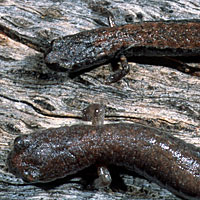 |
 |
Top: B. nigriventris
Bottom: B. m. major
Note the larger body, legs, and toes of B. m. major.
It can be difficult to identify these two species where they both are found because it is hard to tell them apart unless they are side by side and that is not often possible.
You can't always tell just by the body color alone. The best way to determine the species is to look at the coloring of the underside. (See pictures to the right.)
|
Left: B. nigriventris
Right: B. m. major
Comparison of the undersides of both species.
B. nigriventris is dark in color on the belly and under the tail.
B. m. major is light gray under the tail and throat and not as dark on the belly. |
 |
|
|
Left: B. m. major
Right: B. nigriventris
Both from Los Angeles County © Max Roberts
|
|
|
| |
|
|
|
B. m. major
B. gabrieli |
 |
|
|
|
Left: B. m. major
Right: B. gabrieli - San Gabriel Mountains Slender Salamander (collected by permit)
Note the darker color of B. gabrieli and larger feet and toes. |
|
|
|
| |
|
|
| Habitat |
 |
 |
 |
 |
Coastal sage scrub habitat,
San Diego County
|
Habitat, San Diego County |
Habitat, rocky grasslands
Riverside County |
Habitat, riparian canyon
Los Angeles County |
 |
 |
|
|
Habitat, riparian canyon
Los Angeles County |
Habitat, San Diego County hills |
|
|
| |
|
|
|
| Short Video |
| |
 |
|
| |
A Garden Slender Salamander is discovered under some
trash in a Los Angeles County canyon. |
|
| |
|
|
| Description |
| |
| Size |
Adults are 1 1/4 - 2 1/3 inches long (3.2 - 5.9 cm) from snout to vent, and about twice that length with a full tail.
|
| Appearance |
A small slim salamander, with relatively short limbs and 17-21 costal grooves.
There are 9-12 costal folds between adpressed limbs.
A narrow head, long slender body, very long tail, and conspicuous costal and caudal grooves, give this species the worm-like appearance typical of most Slender Salamanders, however B. m. major is larger with a more robust body than most of the other slender salamander species.
There are four toes on the front and hind feet, which is also typical of Slender Salamanders.
(Other California salamanders have five toes on the hind feet.)
|
| Color and Pattern |
Color varies, but is often gray above with a reddish, pinkish, or copper color on the tail, snout and shoulders, sometimes forming blotches.
Some populations are much darker (uplands of Peninsular Range).
Salamanders from near El Rosario, Baja California, are considerably paler.
A dorsal stripe is often obscure.
The belly is gray with a weak network of melanophores.
The tail is typically paler in color then the belly.
In darker populations, the belly is more densly marked.
I have heard of a study by David Wake
that describes a dark population of B. m. major in southern San Diego County that have a dark belly and tail, but I have not seen the study or seen pictures of the underside. Pictures I've seen of the body show it to be darker than most B. m. major.
|
| Comparison With Sympatric Slender Salamanders |
Sympatric B. nigriventris in Los Angeles and Orange counties.
Can be differentiated by ventral color - dark on B. nigriventris, and light on B. m. major, and by the darker color, smaller, slimmer body, and thinner limbs of
B. nigriventris.
Found about 2 miles from B. gabrieli. (Stebbins 2003)
|
| Life History and Behavior |
A member of family Plethodontidae, the Plethodontid or Lungless Salamanders.
Plethodontid salamanders do not breathe through lungs. They conduct respiration through their skin and the tissues lining their mouth. This requires them to live in damp environments on land and to move about on the ground only during times of high humidity. (Plethodontid salamanders native to California do not inhabit streams or bodies of water but they are capable of surviving for a short time if they fall into water.)
Plethodontid salamanders are also distinguished by their naso-labial grooves, which are vertical slits between the nostrils and upper lip that are lined with glands associated with chemoreception.
All Plethodontid Salamanders native to California lay eggs in moist places on land.
The young develop in the egg and hatch directly into a tiny terrestrial salamander with the same body form as an adult.
(They do not hatch in the water and begin their lives as tiny swimming larvae breathing through gills like some other types of salamanders.) |
| Activity |
Commonly found under rocks, logs, bark, leaf litter, and other surface debris, this salamander also retreats into animal burrows, earthworm tunnels, and crevices in the soil.
Active on rainy or wet nights when temperatures are moderate.
The period of activity is October through May, depending on precipitation, but may continue year-round in irrigated areas.
(I have also received a report of salamander activity in a suburban yard in San Diego County in June, when there can be precipitation there from fog and drizzle.)
|
| Defense |
Slender salamanders use several defense tactics, including:
- Coiling and remaining still, relying on cryptic coloring to avoid detection.
- Uncoiling quickly and springing away repeatedly bouncing over the ground, then remaining still again to avoid detection.
- Detaching the tail, which wriggles on the ground to distract a predator from the salamander long enough for it to escape.
(After its tail is detached or severed, the salamander will grow a new tail.) |
| Diet and Feeding |
Feeds primarily on small arthropods and other small invertebrates.
Feeding behavior is not well known, but other Batrachoseps species are sit-and-wait predators that use a projectile tongue to catch prey. |
| Reproduction |
Reproduction is terrestrial.
Breeding probably occurs from November to January, during the rainy season.
|
| Eggs |
| Females lay strings of up to 10-20 eggs under stones or moist debris. Communal nesting is likely. |
| Young |
Young develop completely in the egg and hatch fully formed.
Hatchlings have been observed in January, and as late as April.
|
| Habitat |
Habitat includes coastal sage scrub and oak woodland in the coastal interior, mixed coniferous forest at high elevations, and on north facing rocky slopes in desert localities. This species is often found in suburban yards and gardens where they benefit from the moisture from irrigation.
|
| Geographical Range |
Endemic to California and Baja California Norte. Found in the coastal interior of Southern California from the foothills of the Santa Monica, San Gabriel and San Bernardino Mountains, south into Baja California to the vicinity of El Rosario. Also found in a few desert localities where they have extended their range eastward through San Gorgonio Pass, at Cabezon and Snow Creek Village, Riverside County, and into the city of Palm Springs, taking advantage of human irrigation and landscaping. They have also been found east of Jacumba in San Diego County.
Found on Santa Catalina Island, all four of the Coronados Islands, and Todos Santo Island.
Most likely introduced to Santa Catalina Island and to the Coronados Islands.
(Jockush, et al 2020)
|
| Range Introductions |
Probably introduced to Santa Catalina Island and to the Coronados Islands.
Introduced into the San Joaquin Valley at Hanford in Kings County where they live in irrigated residential gardens. These salamanders, or their eggs, may have been accidentally transferred to the region in shipments of plants from commercial nurseries in southern California, where the salamanders are native.
Also found introduced into
Bakersfield, Kern County, in 2015.
(Jockush, et al 2020) ***
|
 |
| Elevational Range |
Occurs from sea level to around 4000 ft. on Mt. Palomar, San Diego County
|
| Notes on Taxonomy |
B. m. major is allied to the pacificus group of slender salamanders. It had long been placed as a subspecies of B. pacificus, until recent studies showed it was distinct.
Some texts show Batrachoseps aridus as a full species, but in 2000, using DNA studies, Jockusch and Wake * reduced B. aridus to a subspecies of Batrachoseps major, making it B. m. aridus, and the rest the subspecies B. major major.
Martínez-Solano et al show two major lineages of B. major, which contact very approximately in mid San Diego County, however they conclude that these northern and southern lineages should be retained in a single species until more evidence is found to split them into two species. They also state that
"Contrary to prior expectations, B. major has experienced extensive diversification on the Baja California Peninsula, where four endemic lineages have persisted for at least 4 million years."
(Martinez-Solano et al, 2012) **
Jockush, et al found a lot of diversity in the northern lineage of B. major, showing that it "...harbors at least eight deeply differentiated, geographically cohesive mitochondrial subclades." They conclude that the B. major found on Santa Catalina Island were introduced to the island. They also conclude that two populations of B. major far outside the native range in the Central Valley at Hanford and Bakersfield were introduced, which they suggest occured through the nursery trade.
(Jockush, et al 2020) ***
Here's a Diagram of the Batrachoseps Complex showing the relationships between species.
Alternate and Previous Names (Synonyms)
Batrachoseps major - Southern California Slender Salamander - CA Department of Fish and Wildlife
Batrachoseps major major - Garden Slender Salamander (Stebbins 2003, 2012)
Batrachoseps pacificus major - Garden Slender Salamander (Stebbins 1985)
Batrachoseps pacificus catalinae - Santa Catalina Slender Salamander (Stebbins 1996)
Batrachoseps pacificus major - Garden Slender Salamander (Stebbins 1996)
Batrachoseps attenuatus major - Garden Salamander (Camp's Salamander) (Bishop 1943)
Batrachoseps attenuatus leucopus - Southern Slender Salamander (Bishop 1943)
Batrachoseps attenuatus catalinae - Catalina Island Salamander (Bishop 1943)
Batrachoseps major - Garden Salamander (Storer 1925)
Batrachoseps major - Garden Salamander (Grinnell and Camp 1917)
Batrachoseps major (Camp 1915)
Batrachoseps attenuatus (Cope 1883)
|
| Conservation Issues (Conservation Status) |
| The range of this species has been significantly fragmented and much of the habitat has been destroyed due to land development. |
|
| Taxonomy |
| Family |
Plethodontidae |
Lungless Salamanders |
Gray, 1850 |
| Genus |
Batrachoseps |
Slender Salamanders |
Bonaparte, 1841 |
| Species |
major |
Southern California Slender Salamander |
Camp, 1915 |
Subspecies
|
major |
Garden Slender Salamander |
Camp, 1915 |
|
Original Description |
Camp, 1915 - Univ. California Publ. Zool., Vol. 12, No. 12, p. 327
|
|
Meaning of the Scientific Name |
Batrachoseps: Greek - amphibian, frog lizard - describes lizard-like appearance.
major: Latin - larger or greater (it was thought to be the largest Batrachoseps.)
from Scientific and Common Names of the Reptiles and Amphibians of North America - Explained © Ellin Beltz
|
|
Similar Neighboring Salamanders |
B. nigriventris
B. m. aridus
B. pacificus
|
|
More Information and References |
California Department of Fish and Wildlife
AmphibiaWeb
SDNHM
Stebbins, Robert C., and McGinnis, Samuel M. Field Guide to Amphibians and Reptiles of California: Revised Edition (California Natural History Guides) University of California Press, 2012.
Stebbins, Robert C. California Amphibians and Reptiles. The University of California Press, 1972.
Flaxington, William C. Amphibians and Reptiles of California: Field Observations, Distribution, and Natural History. Fieldnotes Press, Anaheim, California, 2021.
Samuel M. McGinnis and Robert C. Stebbins. Peterson Field Guide to Western Reptiles & Amphibians. 4th Edition. Houghton Mifflin Harcourt Publishing Company, 2018.
Stebbins, Robert C. A Field Guide to Western Reptiles and Amphibians. 3rd Edition. Houghton Mifflin Company, 2003.
Behler, John L., and F. Wayne King. The Audubon Society Field Guide to North American Reptiles and Amphibians. Alfred A. Knopf, 1992.
Powell, Robert., Joseph T. Collins, and Errol D. Hooper Jr. A Key to Amphibians and Reptiles of the Continental United States and Canada. The University Press of Kansas, 1998.
Bartlett, R. D. & Patricia P. Bartlett. Guide and Reference to the Amphibians of Western North America (North of Mexico) and Hawaii. University Press of Florida, 2009.
Bishop, Sherman C. Handbook of Salamanders. Cornell University Press, 1943.
Lannoo, Michael (Editor). Amphibian Declines: The Conservation Status of United States Species. University of California Press, June 2005.
Petranka, James W. Salamanders of the United States and Canada. Smithsonian Institution, 1998.
* Jockusch, Elizabeth and David Wake. Detecting Species Borders Using Diverse Data Sets. Pp. 95-119. In Bruce, Jaeger and Houck (editors). The Biology of Plethodontid Salamanders. Kluwer Academic/Plenum Publishers, New York, 2000.
** Martínez-Solano I, Peralta-García A, Jockusch EL, Wake DB, Vázquez-Domínguez E, Parra-Olea G.
Molecular systematics of Batrachoseps (Caudata, Plethodontidae) in southern California and Baja California: Mitochondrial-nuclear DNA discordance and the evolutionary history of B. major. Mol Phylogenet Evol. 2012 Jan 21. [Epub ahead of print]
Joseph Grinnell and Charles Lewis Camp. A Distributional List of the Amphibians and Reptiles of California. University of California Publications in Zoology Vol. 17, No. 10, pp. 127-208. July 11, 1917.
*** Jockusch EL, Hansen RW, Fisher RN, Wake DB. 2020. Slender salamanders (genus Batrachoseps) reveal Southern California to be a center for the diversification, persistence, and introduction of salamander lineages. PeerJ 8:e9599 https://doi.org/10.7717/peerj.9599)
|
|
|
The following conservation status listings for this animal are taken from the April 2024 State of California Special Animals List and the April 2024 Federally Listed Endangered and Threatened Animals of California list (unless indicated otherwise below.) Both lists are produced by multiple agencies every year, and sometimes more than once per year, so the conservation status listing information found below might not be from the most recent lists. To make sure you are seeing the most recent listings, go to this California Department of Fish and Wildlife web page where you can search for and download both lists:
https://www.wildlife.ca.gov/Data/CNDDB/Plants-and-Animals.
A detailed explanation of the meaning of the status listing symbols can be found at the beginning of the two lists. For quick reference, I have included them on my Special Status Information page.
If no status is listed here, the animal is not included on either list. This most likely indicates that there are no serious conservation concerns for the animal. To find out more about an animal's status you can also go to the NatureServe and IUCN websites to check their rankings.
Check the current California Department of Fish and Wildlife sport fishing regulations to find out if this animal can be legally pursued and handled or collected with possession of a current fishing license. You can also look at the summary of the sport fishing regulations as they apply only to reptiles and amphibians that has been made for this website.
This salamander is not included on the Special Animals List, meaning there are no significant conservation concerns for it in California according to the California Department of Fish and Game.
|
| Organization |
Status Listing |
Notes |
| NatureServe Global Ranking |
|
|
| NatureServe State Ranking |
|
|
| U.S. Endangered Species Act (ESA) |
None |
|
| California Endangered Species Act (CESA) |
None |
|
| California Department of Fish and Wildlife |
None |
|
| Bureau of Land Management |
None |
|
| USDA Forest Service |
None |
|
| IUCN |
|
|
|
|
|








































